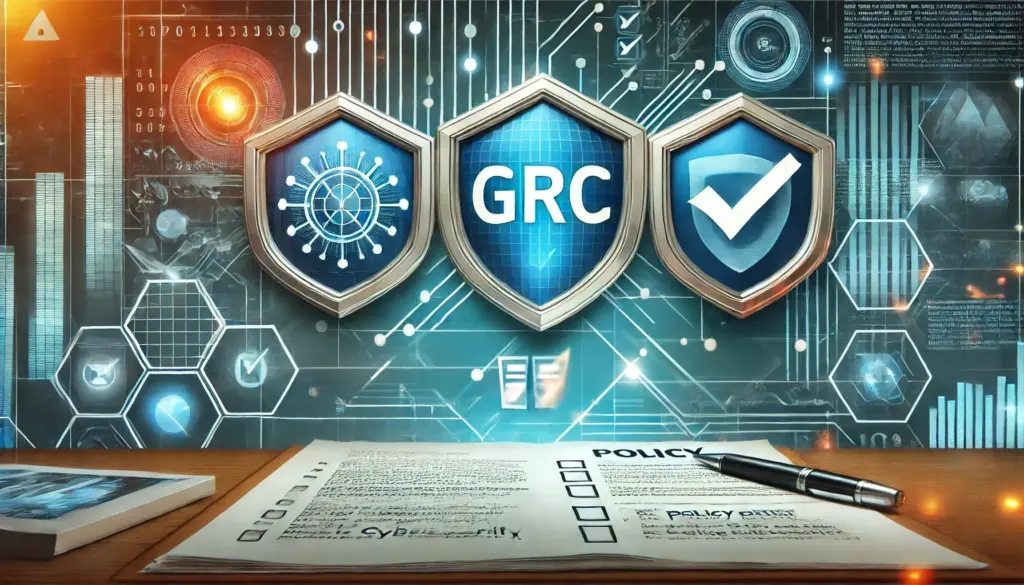In today’s rapidly evolving digital landscape, organizations face growing threats from cyberattacks, regulatory demands, and operational complexities. As a Chief Information Security Officer (CISO), mastering Governance, Risk, and Compliance (GRC) is critical to safeguarding your organization while driving strategic value. But what exactly does GRC entail, and why is it so important?
Let’s explore how GRC serves as the foundation for robust cybersecurity practices and how CISOs can implement it effectively.
What is GRC?
GRC stands for Governance, Risk, and Compliance, a structured approach to aligning an organization’s operations with its business objectives, managing risks, and ensuring adherence to legal and regulatory requirements. While each component of GRC has its unique focus, together they form a comprehensive framework for securing an organization’s information assets.
1. Governance: Setting the Direction
Governance provides the strategic framework for decision-making, accountability, and performance within an organization. It defines the policies, processes, and roles required to achieve security objectives while ensuring alignment with business goals.
Key Elements of Governance:
- Policy Development: Governance starts with clear and enforceable security policies, such as acceptable use policies, access controls, and data classification standards. These policies act as a roadmap for maintaining consistency across the organization.
- Security Strategy: CISOs must craft a long-term strategy that balances innovation with security. This involves prioritizing initiatives that mitigate risks while enabling business growth.
- Metrics and Reporting: Governance is incomplete without measuring its effectiveness. Key Performance Indicators (KPIs) and Key Risk Indicators (KRIs) help track the organization’s cybersecurity posture and inform decisions at the executive level.
Example: A governance policy might define who is authorized to access sensitive customer data and how that data should be protected.
2. Risk Management: Identifying and Mitigating Threats
Risk management is the process of identifying, assessing, mitigating, and monitoring risks that could impact an organization’s operations or reputation. As cyber threats evolve, effective risk management is vital for proactive defense.
Key Steps in Risk Management:
- Risk Assessment: Evaluate potential threats and vulnerabilities. For example, phishing attacks, insider threats, or misconfigured cloud resources can introduce significant risks. Tools like risk matrices or quantitative methods (e.g., FAIR – Factor Analysis of Information Risk) help assess their likelihood and impact.
- Risk Mitigation: Once risks are identified, apply controls to reduce them to an acceptable level. Implementing technologies like multi-factor authentication (MFA) and encryption are common mitigation strategies.
- Risk Acceptance and Transfer: Not all risks can be eliminated. Some may need to be accepted or transferred through mechanisms like cyber insurance.
- Continuous Monitoring: Use tools such as SIEM (Security Information and Event Management) to monitor risks in real-time and respond to incidents promptly.
Example: A CISO identifies a vulnerability in the organization’s email system that could allow phishing attacks. They implement training for employees and introduce advanced threat protection tools to mitigate the risk.
3. Compliance: Adhering to Regulations
Compliance ensures that the organization meets legal, regulatory, and industry-specific requirements. Beyond avoiding penalties, maintaining compliance builds trust with stakeholders and protects brand reputation.
Key Aspects of Compliance:
- Understanding Regulations: CISOs must be familiar with regulations relevant to their industry and geography, such as:
- GDPR: Data privacy in the European Union.
- PCI DSS: Security standards for payment card information.
- HIPAA: Safeguards for healthcare information.
- Audits and Assessments: Regular audits and assessments ensure compliance efforts are effective. Performing gap analyses helps identify areas needing improvement.
- Documentation: Maintaining thorough records, such as incident logs and risk assessments, demonstrates compliance during audits.
- Training and Awareness: Compliance requires organization-wide involvement. Regular employee training ensures that everyone understands their role in maintaining compliance.
Example: To comply with GDPR, a company implements policies to encrypt sensitive customer data, provides opt-out options for marketing communications, and documents all data-handling processes.
How GRC Works Together
Governance, Risk, and Compliance are interconnected, and their combined implementation provides a holistic approach to cybersecurity:
| Governance | Risk Management | Compliance |
|---|---|---|
| Defines policies and objectives. | Identifies and mitigates risks. | Ensures adherence to regulations. |
| Aligns security with business goals. | Minimizes operational disruptions. | Avoids penalties and builds trust. |
Example in Action:
- Governance: A policy mandates encryption for sensitive customer data.
- Risk Management: The IT team identifies unsecured data transfers as a risk and deploys encryption tools.
- Compliance: The organization meets GDPR encryption requirements and passes audits with ease.
Why GRC is Critical for CISOs
- Strategic Alignment: GRC ensures that security initiatives support organizational objectives, enabling growth without compromising safety.
- Risk Reduction: Identifying and mitigating risks minimizes disruptions and protects critical assets.
- Regulatory Adherence: Staying compliant avoids fines, legal challenges, and reputational damage.
- Stakeholder Trust: A robust GRC framework reassures customers, partners, and investors of your organization’s commitment to security.
Practical Tips for Implementing GRC
- Start with a Framework: Leverage standards like NIST CSF, ISO 27001, or COBIT to structure your GRC program.
- Engage Stakeholders: Involve cross-functional teams to ensure GRC policies are practical and widely adopted.
- Leverage Technology: Use tools for risk assessment, compliance tracking, and monitoring to streamline GRC efforts.
- Continuous Improvement: Regularly review and update your GRC framework to address emerging threats and changing regulations.
Conclusion
Governance, Risk, and Compliance are not just buzzwords; they are essential pillars of effective cybersecurity management. For CISOs, mastering GRC is about more than meeting regulatory requirements – it’s about aligning security with business goals, building resilience, and fostering trust. By implementing a robust GRC framework, you can protect your organization from risks and empower it to thrive in today’s complex digital environment.


